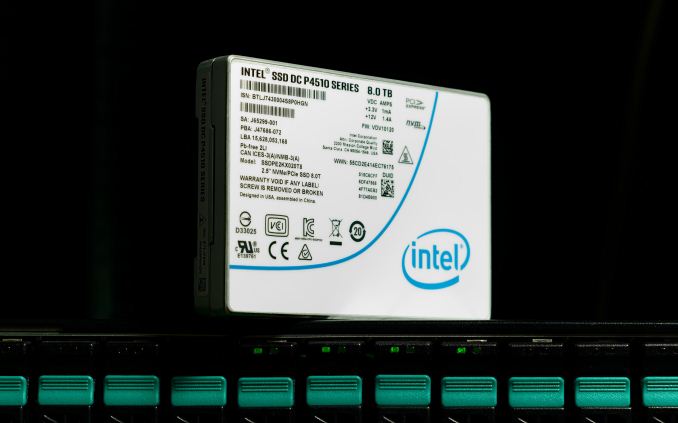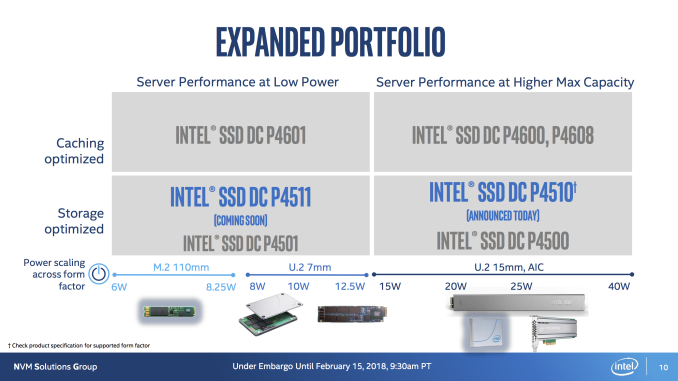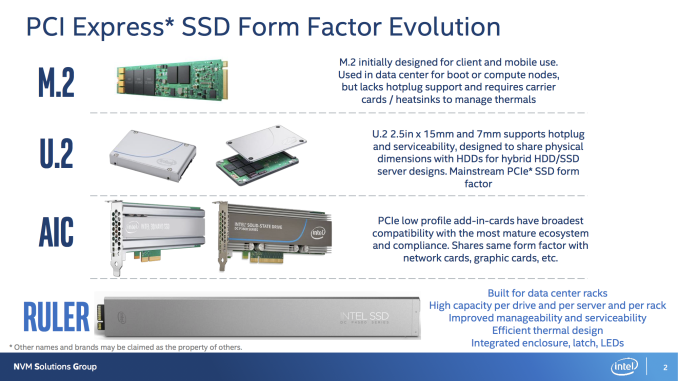The Intel SSD DC P4510 SSD Review Part 1: Virtual RAID On CPU (VROC) Scalability
by Billy Tallis on February 15, 2018 3:00 PM EST- Posted in
- SSDs
- Storage
- Intel
- RAID
- Enterprise SSDs
- NVMe
- U.2
- Purley
- Skylake-SP
- VROC

Today, Intel is introducing their 64-layer 3D TLC NAND to the enterprise SSD market with the new Intel SSD DC P4510 NVMe drive. They are also finally giving us a chance to test the Virtual RAID On CPU feature introduced with the Skylake-SP and Skylake-X processors last year. Intel has provided four 2TB P4510 SSDs to test against the 8TB model, plus the much sought-after VROC Premium hardware key to unlock the full range of NVMe RAID features on this platform.
The Intel SSD DC P4510 is Intel's first enterprise SSD to use their 64-layer 3D NAND flash memory. The P4510 uses the same second-generation Intel NVMe SSD controller as the other P45xx and P46xx drives introduced last year with 32-layer 3D NAND. With the Optane SSD DC P4800X now covering the highest product segment, Intel's flash-based enterprise NVMe drives are now divided into just two performance and endurance tiers. The P4510 falls into the cheaper tier of drives with much lower write performance and write endurance ratings that are generally between 0.5 drive writes per day (DWPD) and 1 DWPD. The DC P46xx tier has write endurance ratings around 3 DWPD (and the Optane SSD DC P4800X is rated for 30 DWPD).
Intel regards the P45xx tier of products as intended for high-capacity primary storage usage, while the P46xx drives are targeted for use as a cache layer. With their second-generation NVMe controller, Intel is also dividing their enterprise NVMe SSD family on another axis. Unlike the controller used on the P3xxx series, new controller is small enough to fit on a M.2 card, and can operate within the power limits of that form factor. A month after first announcing the P4500 and P4600, Intel introduced the low-power P4501 as their first M.2 drive with an in-house controller. The P4501 is also available as a 7mm thick U.2 drive, compared to the 15mm thickness of the high-power U.2 drives. The P4510 falls into that high-power category, but the smaller capacities are rated for just 10W active power, which is comparable to the 2.5" version of the P4501.
| Intel SSD DC P4510 Specifications | |||||
| Capacity | 1 TB | 2 TB | 4 TB | 8 TB | |
| Form Factor | 2.5" 15mm U.2 | ||||
| Interface | PCIe 3.1 x4 NVMe 1.2 | ||||
| Memory | Intel 512Gb 64-layer 3D TLC | ||||
| Sequential Read | 2850 MB/s | 3200 MB/s | 3000 MB/s | 3200 MB/s | |
| Sequential Write | 1100 MB/s | 2000 MB/s | 2900 MB/s | 3000 MB/s | |
| Random Read | 469k IOPS | 624k IOPS | 625.5k IOPS | 620k IOPS | |
| Random Write | 72k IOPS | 79k IOPS | 113.5k IOPS | 139.5k IOPS | |
| Maximum Power | Active | 10 W | 10 W | 14 W | 16 W |
| Idle | 5 W | 5 W | 5 W | 5 W | |
| Write Endurance | 1.1 DWPD | 0.7 DWPD | 0.9 DWPD | 1.0 DWPD | |
| Warranty | 5 years | ||||
Compared to the Intel SSD DC P4500, the biggest performance gains the P4510 brings are to write speeds. Random write performance is more than doubled, and sequential write performance is 60-90% higher. With those performance increases and the reduced power consumption, the Intel claims the P4510 offers twice the performance per watt on some workloads.
Intel has also tuned the P4501's firmware to offer much better quality of service. A major part of this is that the P4510 is better about prioritizing read operations over flash program or erase operations, leading to an order of magnitude improvement in 99.99th percentile read latency. The P4510 also benefits from the 64L 3D TLC's flash program latency, which is about half that of Intel's 32L 3D NAND.
While today marks the first official announcement of the P4510, the 1TB and 2TB capacities started shipping to some large cloud providers in 2017. New today are the 4TB and 8TB models, and the full line will be more broadly available starting this quarter. With a broad range of capacities, and lower prices and higher performance enabled by the transition to 64L 3D NAND, Intel is expecting the P4510 to be their best-selling SSD this year. For now, the P4510 is only available as a 2.5" U.2 drive, but in the future Intel may introduce other form factors, including EDSFF—the now-standardized version of the Intel Ruler concept.
We have only had a few days to play with the Intel SSD DC P4510 and Intel VROC, so the benchmark results in this review are very limited. This review focuses solely on the performance of the P4510 and the scalability limits of Intel VROC. Follow-up reviews will provide our usual in-depth analysis of single-drive performance and power efficiency as compared against other enterprise NVMe SSDs, compare VROC performance between Windows and Linux, and VROC performance with an Optane cache. We will also test VROC with our client SSD test suite and Samsung 960 PRO consumer SSDs.












21 Comments
View All Comments
MrSpadge - Friday, February 16, 2018 - link
> On a separate note - the notion of paying Intel extra $$$ just to enable functions you've already purchased (by virtue of them being embedded on the motherboard and the CPU) - I just can't get around it appearing as nothing but a giant ripoff.We take it for granted that any hardware features are exposed to us via free software. However, by that argument one wouldn't need to pay for any software, as the hardware to enable it (i.e. a x86 CPU) is already there and purchased (albiet probably from a different vendor).
And on the other hand: it's apparently OK for Intel and the others to sell the same piece of silicon at different speed grades and configurations for different prices. Here you could also argue that "the hardware is already there" (assuming no defects, as is often the case).
I agree on the anti trust issue of cheaper prices for Intel drives.
boeush - Friday, February 16, 2018 - link
My point is that when you buy these CPUs and motherboards, you automatically pay for the sunk R&D and production costs of VROC integration - it's included in the price of the hardware. It has to be - if VROC I is dud and nobody actually opts for it, Intel has to be sure to recoup its costs regardless.That means you've already paid for VROC once - but you now have to pay twice yo actually use it!
Moreover, the extra complexity involved with this hardware key-based scheme implies that the feature is necessarily more costly (in terms of sunk R&D as well as BOM) than it could have been otherwise. It's like Intel deliberately and intentionally set out to gouge its customers from the early concept stage onward. Very bad optics...
nivedita - Monday, February 19, 2018 - link
Why would you be happier if they actually took the trouble to remove the silicon from your cpu?levizx - Friday, February 16, 2018 - link
> However, by that argument one wouldn't need to pay for any software, as the hardware to enable itThat's a ridiculous claim, the same vendor (SoC vendor, Intel in this case) does NOT produce "any software" (MSFT etc). VROC technology in ALREADY embedded in the hardware/firmware.
BenJeremy - Friday, February 16, 2018 - link
Unless things have changed in the last 3 months, VROC is all but useless unless you stick with intel-branded storage options. My BIL bought a fancy new Gigabyte Aorus Gaming 7 X299 motherboard when they came out, then waited months to finally get a VROC key. It still didn't allow him to make a bootable RAID-0 array the 3 Samsung NVMe sticks. We do know that, in theory, the key is not needed to make such a setup work, as a leaked version of Intel's RST allowed a bootable RAID-0 array in "30-day trial mode".We need to stop falling for Intel's nonsense. AMD's Threadripper is turning in better numbers in RAID-0 configurations, without all the nonsense of plugging in a hardware DRM dongle.
HStewart - Friday, February 16, 2018 - link
"We need to stop falling for Intel's nonsense. AMD's Threadripper is turning in better numbers in RAID-0 configurations, without all the nonsense of plugging in a hardware DRM dongle."Please stop the nonsense of fact less claims about AMD and provide actual proof about performance numbers. Keep in mind this SSD is an enterprise product designed for CPU's like Xeon not game machines.
peevee - Friday, February 16, 2018 - link
Like it.But idle power of 5W is kind of insane, isn't it?
Billy Tallis - Friday, February 16, 2018 - link
Enterprise drives don't try for low idle power because they don't want the huge wake-up latencies to demolish their QoS ratings.peevee - Friday, February 16, 2018 - link
4-drive RAID0 only overcomes 2-drive RAID0 by QD 512 . What kind of a server can run 612 threads at the same time? And what kind of server you will need for full 32 Ruler 1U backend (which would require 4192 threads to take advantage of all that power)?kingpotnoodle - Sunday, February 18, 2018 - link
One use could be shared storage for I/O intensive virtual environments, attached to multiple hypervisor nodes, each with multiple 40Gb+ NICs for the storage network.